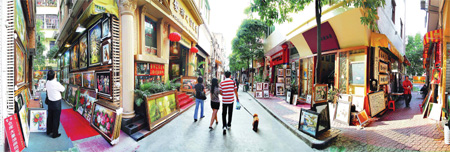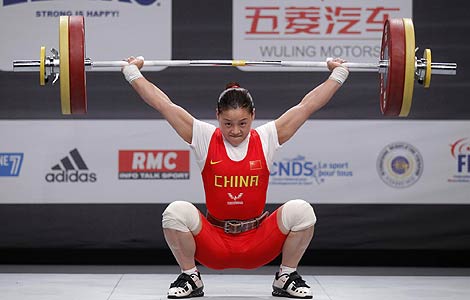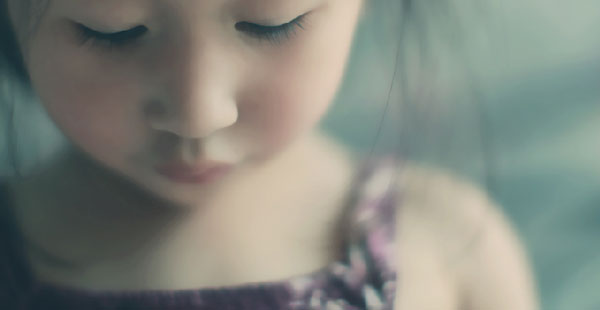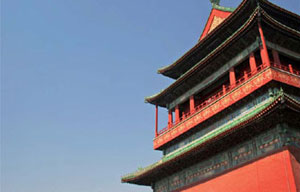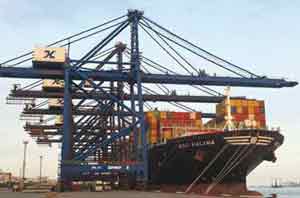Eye on the future
Updated: 2011-11-04 08:55
By Liu Lu (China Daily)
|
|||||||||
Urban village looks to establish a lasting, original presence on global art map
After two decades of rapid growth propelled by sales of oil painting reproductions, Dafen is now reinventing itself as the destination of choice for original art. Part of the reason why Dafen, an urban village in the manufacturing hub of Shenzhen, is looking to shed its tinged
|
|
According to Peng, the endeavor of all future efforts are trained at changing the paintings tagged with labels like "made in Dafen'" to "created in Dafen."
"What this means is more than the change to a single word. Rather it signifies the resolution of an entire village to upgrade its business model by striving for originality," he says.
"Imitation works have made Dafen a world-famous art zone and greatly supported the growth of the local economy. But it is the original paintings that will help Dafen gain a foothold in the high-end international art market in the future," Peng says, adding that many artists have already shifted to creation of original art works.
But what sets Dafen apart from other global art villages is the slew of orderly arranged oil painting workshops and the distinctive artistic atmosphere.
Spread over 405 hectares, the small village already has the reputation of being the largest mass producer of copied oil paintings in the world, and accounts for over 60 percent of the global total trade volume in oil paintings.
"It is not an exaggeration that at least 50 percent of the oil paintings hung on the walls in the United States and Europe are from Dafen," says Zhou Xiaohong, vice-president of the Art Industry Association in Dafen.
As one of the first artists in Dafen, Zhou has witnessed the dramatic transformation of the village from a poor fishing hamlet inhabited by about 300 people in the late 1980s to the world's leading oil painting manufacturing hub, which now boasts more than 6,000 painters and 1,100 art galleries, studios, and art-related businesses.
|
Dafen village in Shenzhen is home to more than 6,000 painters and 1,100 art galleries, studios and other art-related businesses. [Provided to China Daily] |
According to the Shenzhen statistics bureau, the output value of Dafen's oil painting business was 3.5 billion yuan ($550 million, 400 million euros) in 2010, and it is likely to surpass the 4-billion-yuan mark this year.
"Dafen's emergence as a huge art cluster has helped Shenzhen, China's first special economic zone, to shed the tag of a 'cultural desert'," Zhou says.
According to Zhou, artists in Dafen are not unduly worried about copyright infringements, because almost all the copied masterpieces are drawn by famous artists who died 50 years ago and hence do not enjoy any copyright protection. But there are also some new and famous artists who are willing to be imitated, as it is a sure-fire way of improving visibility.
With the ability to efficiently produce copies of original paintings in bulk and its proximity to Hong Kong, the replication business developed at a surprising speed in Dafen. Oil paintings from Dafen have enjoyed success in the US and Europe because of their high quality and affordable prices.
Undoubtedly the best-seller in Dafen is the replica of Mona Lisa. A fast painter can draw up to seven or eight copies a day. A reproduction of Da Vinci's enigmatic lady costs just 200 yuan at a wholesaler in Dafen, but commands prices of over $2,000 (1,463 euros) in a US gallery, says Zeng Qunce, 42, a veteran artist from Dafen.
|
 Reproductions make Dafen the world's largest mass producer of oil paintings. [Liu Lu / China Daily]
|
"Although drawing replicas is easier than original ones, it means we stay at the bottom of the supply chain and hence are most vulnerable to market wobbles," Zeng says. He worked as a copy worker for many years but started his own creations in 2008.
Before 2008, 90 percent of the imitation works in Zeng's shop were sold to art dealers from the US and Europe.
"Hotels and house owners in the US and Europe were the largest consumers in Dafen before the global financial crisis."
But with overseas orders plummeting, many like Zeng have been forced to scout for better prospects in the domestic markets.
"With the rapid improvement in living standards, domestic demand for oil paintings has been rapidly rising in recent years. But unlike Westerners, Chinese buyers are not too keen on copies of masterpieces," Zeng says.
"My abstract-styled oil paintings are extremely popular among Chinese buyers, and I draw on average 100 such paintings every year," he says.
Zeng says that sales proceeds from the 100 paintings match up to sales of over 1,000 Mona Lisa copies at a US gallery. "Domestic sales account for over 40 percent of the total turnover," Zeng says.
Aside from the economic benefits, Zeng says original artworks also give an experience of having accomplished something. In the past few years, several of his original artworks have been displayed at prominent art exhibitions in China and Europe, thereby boosting his popularity.

